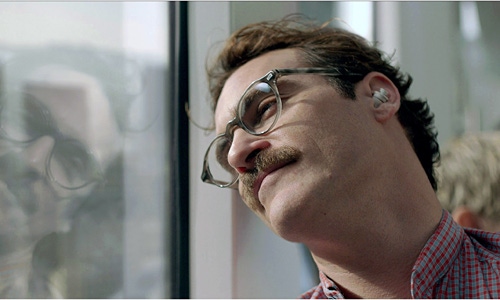Making Healthcare Like the Movie 'Her': A Conversation about Invisibles
Karten Design's Stuart Karten and Misfit CEO Sonny Vu talk about invisibility, implantables, smart toilets and the future of wearables.
October 7, 2014

Stuart Karten thinks the world needs to look more like the movie Her, especially with regards to health. “Today it seems like we're obsessed with screen size, resolution, thickness, new gestures, and bendablity,” the principal of Marina del Rey, CA-based Karten Design told the audience at the 2014 USC Body Computing Conference. “Serious issues to be considered, but certainly not going to lead us to the solutions of the future.”
In the film Her the technology behind Samantha (voiced by Scarlett Johansson)– the artificially intelligent operating system – never draws attention to itself. It simply exists, allowing Joaquin Phoenix's character to work, manage his schedule, play video games, and even fall in love without a device ever intruding into his life. Samantha is simply there. She's invisible and around him at all times.
Karten envisions this same future for healthcare—a world away from wearables and toward what he dubs “invisibles,” devices that bring patients and consumers “meaningful information that blends with their existing life habits.”
“We will need to camouflage our devices, make them less intrusive. We'll have to remove the social stigma,” he said. “All in the service of changing behavior, adhering to treatment, complying with medication, and adopting and enabling new health technologies.”
Sonny Vu, founder and CEO of Misfit (formerly Misfit Wearables) was on-hand as well to share commentary with Karten. “I've always been a huge fan of invisible technology. [Misfit] started in wearables because honestly it was just easier, but if you think about it, if you had to wear something, if that was a requirement for your product it better be pretty beautiful or invisible,” Vu said. “And in fact it's at a disadvantage if you compare that to not having to wear something. And, again, there are products that, yes, can be worn. But just because they can be worn doesn't mean they should be or that people want to wear them.”
|
|
Karten | Vu |
Vu noted that Misfit dropped the Wearables from its company name because it believes there are more exiting areas to explore beyond wearables. “That's really what we're in the thick of now, this era of connected devices where technology really will melt into the background, where we're aren't just staring or glancing at glowing rectangles all day long.”
Vu shared a Q+A session with Karten where they discussed the possibilities of health technologies beyonod wearables:
Vu: What are your top three challenge of making an ambient, invisible future?
Karten: I think the lens everyone is looking at all of this through is technology and my point is that as people we're kind of simple. We like to be loved, we want to be touched and have interaction. And I would encourage people to move away from that technology lens.
Vu: So maybe the challenges aren't technical.
Karten: At one extreme the challenges are easy because people are simple. Part of what I see as the problem right now is [companies] are just trying to shove technology into people's lives and they don't really want it and they're not used to it and in some cases it's actually rude and bad behavior.
The thing I see happening is the Internet of Things right? Look at Nest and all these products that are being brought into the home and doing amazing things, giving you all this opportunity. And if you think about all this consumer product work that's being done on wearables and then the medical piece, when you start to overlay all this, that is where you really start to see some interesting things. The technology and the regulatory piece all of that makes it a little bit cloudy but I believe it's eventually going to be the future.
Vu: When you look at the movie Her and how wondrous some of those technologies can be. How close are we to that? It seems really kind of far away.
Karten: I don't necessarily agree with you. Think of it this way. Siri and that sort of voice interaction is starting to pick up and it's getting better. So if you can image that moving up on a higher level, which would then give you something close to Scarlett Johansson with that virtual human, and then take broadband connectivity and trying to amp up that level that's a part of what needs to happen. And I think the other piece is that algorithm piece. I think there's a lot of work going on in that area. I think those things are amping up and moving in a direction where these things could converge and it might not be that far off.
Vu: We love invisible technology at Misft, that's why we launched Beddit. What else is there? If the future is not just wearable. What about the smart home? What are the top three, near-term most interesting smart home products that might make Samantha a little bit more real?
Karten: There are things [Karten Design is] working on now that I can't really talk about. But if you think about the environments in the home where things really happen and that have to do with health your money would naturally go to the bathroom.
Vu: A smart toilet?
Karten: Possibly.
Vu: So... 'You pooped three times last week.” What's that going to do for me?
Karten: Any doctor will tell you there's a lot of information that can be gleaned. So I wouldn't discount that.
Learn about the latest developments in wearbles and sensor technologies at MD&M Chicago. Oct. 15-16, 2014 |
Vu: One of our customers loves toilets and is investing in them. And apparently there's a huge cluster of companies working in the smart toilet space. But what other things can you get?
Karten: The other thing I thing that is happening that I think is interesting is this whole idea of implantables. [Karten Design is] working with a company, Endotronix, they put a sensor in your pulmonary artery, it sits there passively, it doesn't need to be powered, you don't have to charge it, and you can just read out from it. You probe it, and read the data and it's a great preventative tool for heart failure. So this idea of putting things into the body I think is something people are going to warm up to and start think about.
Vu: I always wonder about the whole medical angle. Are people really going to wear implantable devices? I came from the diabetes world where we had people wearing insulin pumps that were life changing. But so many people still don't wear them even though they're paid for by insurance and they're clinically proven to improve quality of care. People just don't wear them and I know so many people with diabetes that don't wear these things.
Karten: They need to be a little more invisible Sonny.
Vu: (laughs) Maybe. I mean some people just don't want to know their glucose level. I've heard of that as well. But that's another issue.
Karten: Again, I think will people, just for quantification, stick things in their body or stick things into their body? I question that. But if you're dealing with chronic diseases like diabetes or things where you can make a difference, where you can really affect somebody's quality of life, I say have at it.
[This talk has been edited for space and clarity]
-Chris Wiltz, Associate Editor, MD+DI
You May Also Like




